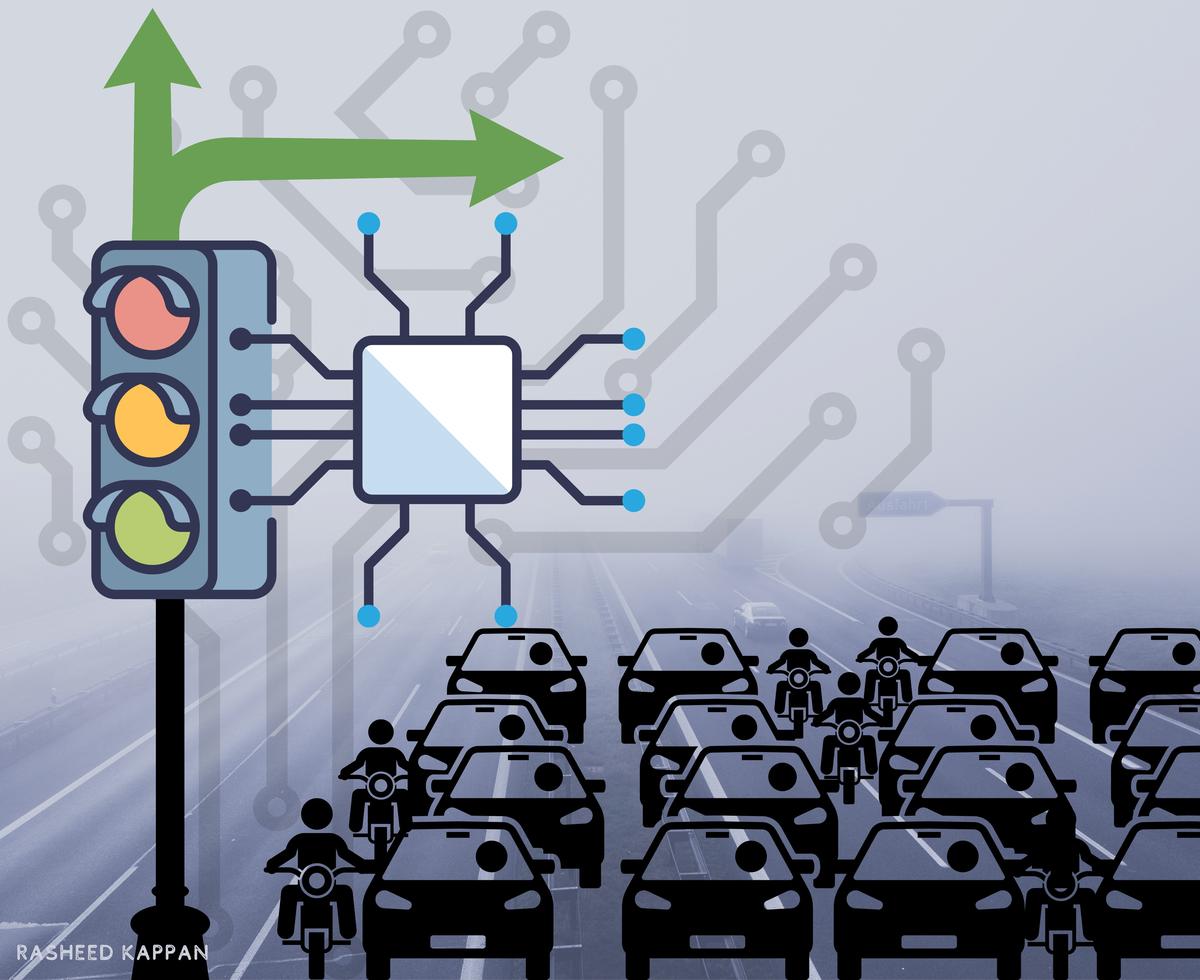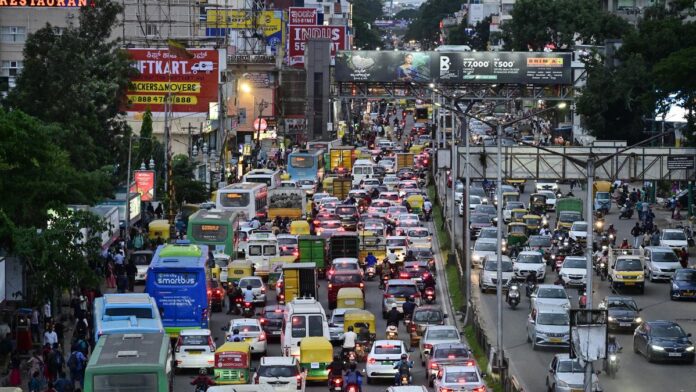The absolute post-flood chaos on Bengaluru’s streets was predictable all the way. The only surprise was why it created a flutter at all. But as the onslaught of new vehicular registrations continue unabated, can retrofitting the city’s traffic management systems with Artificial Intelligence (AI) and other tech interventions work? Mixed results from the recent installation of AI sensors have only complicated the system.
The Bangalore Traffic Police (BTP) say the new AI traffic signals have brought down travel time by a third at key intersections. But ground reports show the impact is nowhere near so dramatic. Public verdict on the Bengaluru Adaptive Traffic Control System (BATCS) is not out yet, although seasoned traffic planners are pitching for a more traditional synchronised signalling method.
Launched in May this year, the project uses adaptive signals with camera sensors that track real-time traffic flow and adjust the red and green lights accordingly. The timings are dynamic unlike the fixed ones. So far, the signals have been put up at 60 junctions. BTP has proposed to extend the system to 165 junctions by January 2025 and 250 by March.
Peak-hour challenges
AI-based signals could work well if the vehicular load is manageable. But peak-hour traffic at junctions across the city is anything but that. BTP claims that the adaptive signals operate automatically most of the time. During peak hours, the Vehicle Actuated Control (VAC) or Adaptive Traffic Control System (ATCS) is activated.
Traffic at a majority of junctions is at a saturated level during the morning and evening peak hours. This implies vehicles would have to wait for more than one signal cycle to pass through, explains Dr. Ashish Verma, a traffic and transportation expert and convenor, Sustainable Transportation Lab at the Indian Institute of Science (IISc). “In such situations, vehicular volumes overshoot the junction’s capacity. Here, AI has a very negligible impact on travel time,” he says.
The only way out is to increase the junction capacity by reducing vehicular load, a virtually impossible task today. “Only then can you optimise the functionality. AI could be of some help during off-peak hours. But it has to be backed by proper planning and policy that control the number and use of vehicles,” contends the seasoned transport analyst.

AI Traffic
| Photo Credit:
Rasheed Kappan
Algorithms alien to Indian traffic
Besides, there is the hardware issue. AI sensors might sound fancy, but are they based on algorithms linked to Indian road traffic conditions? As Dr. Ashish points out, “Traditionally, these algorithms used to optimise and decide timings are developed in a Western style of traffic condition. For instance, the assumption is at a junction, vehicles will follow a strict First In, First Out (FiFo) queuing pattern and discipline. That is, if you are first to get to the junction, you will be the first to get out.”
Bengaluru’s streets are notorious for lack of lane discipline, and FiFo remains an alien concept to most vehicle-users. “Since we don’t have lane segregation for left turners and right turners, and there is a very heterogeneous mix of vehicular types, gap-filling behaviour is very common. You might have arrived early, but someone else will fill the gap and go ahead in front of you,” he says, indicating a clear lacuna in what the hardware is wired to do and the ground reality.
Signal synchronisation
Signal synchronisation is a proven way out, suggests Additional Director General of Police (ADGP) M.A. Saleem, who had closely tracked and managed the city’s traffic for decades. “Only synchronisation of signalled lights can help in Bengaluru because the volume of traffic is far greater than the capacity of the road. I don’t think any technology will be able to solve that problem,” he notes.
During 2011-12, the city traffic police under Saleem had synchronised the traffic corridor from Minerva Circle to Mysore Bank Circle. “Along this corridor, you could get green signals at six continuous junctions. It helped us reduce congestion. I did it again in 2022, when I came back as the City’s Special Commissioner,” he recalls.
Synchronisation works most efficiently along one-ways with a line of junctions equipped with two-phase signal cycles. “J.C. Road has six such signals, where vehicles get uniform time to pass. A vehicle that leaves Minerva Circle gets an automatic green signal at Bharat Junction, and again at Shivaji Junction till it reaches the Mysore Bank Circle. Another corridor that we did was from Corporation Circle to Lalbagh Main Gate, and from Peenya upto 8th Mile.”
Best for priority corridors
This system works particularly well for a priority corridor, agrees Dr. Ashish. “For example, if you want vehicles on M.G. Road to keep moving along a chain of signals, synchronisation ensures a faster throughput. Green signals are timed in such a way that when a platoon of vehicles is dispatched from the first signal, you get green at the second signal when this platoon arrives there and likewise at the subsequent signals. So it can help decongest at least along that main priority corridor.”
However, he cautions that it might have an impact on the other intersecting roads triggering queues and delays. “But synchronisation will still have a limited order of performance in saturated traffic conditions. There is no escape from saturated conditions at the intersections unless vehicle numbers are brought down.”
No visible change
For Vishwanath H., a car-user who commutes between his Ramamurthynagar residence and M.G. Road office daily, there is no change visible in traffic management. “I was told that when a certain volume of traffic reaches a junction in a particular way, automatically the new AI signal will change and the traffic will move. Or even if pedestrians are waiting, the AI sensor will show green. Honestly, I don’t see that happening,” he says.
He feels the city’s traffic has reached a point where it cannot be managed anymore. “The system will get confused by the huge vehicular volumes, because these things are made for some other part of the world. Besides, the traffic itself is slowing down much before it reaches a junction because the city’s roads have become really bad. They did a mediocre job before the rains, and now all that is washed off,” he laments with a sigh of resignation.
Published – November 08, 2024 09:00 am IST
